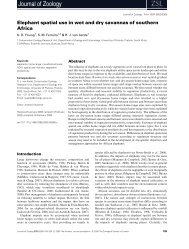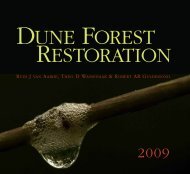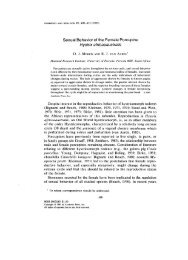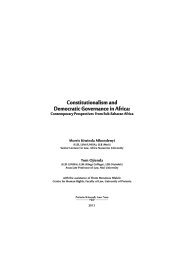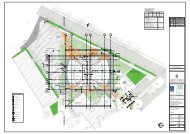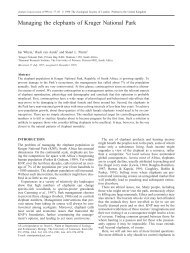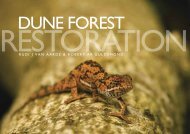Neighbourhood renewal in Cape Town's inner city: Is it gentrification?
Neighbourhood renewal in Cape Town's inner city: Is it gentrification?
Neighbourhood renewal in Cape Town's inner city: Is it gentrification?
Create successful ePaper yourself
Turn your PDF publications into a flip-book with our unique Google optimized e-Paper software.
<strong>Neighbourhood</strong> <strong>renewal</strong> <strong>in</strong> <strong>Cape</strong> Town’s <strong>in</strong>ner <strong>c<strong>it</strong>y</strong>: is <strong>it</strong> <strong>gentrification</strong>?<br />
ISSN 0378-5254 Journal of Family Ecology and Consumer Sciences, Vol 28, 2000<br />
<strong>Neighbourhood</strong> <strong>renewal</strong> <strong>in</strong> <strong>Cape</strong> Town’s <strong>in</strong>ner <strong>c<strong>it</strong>y</strong>:<br />
<strong>Is</strong> <strong>it</strong> <strong>gentrification</strong>?<br />
OPSOMMING/<br />
In hierdie navors<strong>in</strong>g word die stedelike vernuw<strong>in</strong>g<br />
wat <strong>in</strong> die sentrale woonbuurtes van Kaapstad<br />
plaasgev<strong>in</strong>d het, ondersoek. Ses woonbuurtes is<br />
geïdentifiseer as potensiële gentrifikasie-areas.<br />
Data <strong>in</strong> verband met die woonbuurt en behuis<strong>in</strong>gskenmerke,<br />
asook persoonlike en sosiale eienskappe<br />
van die <strong>in</strong>woners, is verkry met behulp van<br />
‘n 10 % sistematiese steekproef. U<strong>it</strong> ‘n voorlopige<br />
ondersoek, waar<strong>in</strong> die verskillende veranderlikes<br />
afsonderlik hanteer is, was d<strong>it</strong> duidelik dat sommige<br />
areas meer met <strong>in</strong>ternasionale bev<strong>in</strong>d<strong>in</strong>ge oor gentrifikasie<br />
ooreengestem het as ander.<br />
‘n Gentrifikasieprofiel is vervolgens vir Kaapstad<br />
saamgestel met behulp van diskrim<strong>in</strong>antanalise.<br />
Hieru<strong>it</strong> was d<strong>it</strong> duidelik dat persoonlike eienskappe<br />
soos kwalifikasie, beroep, <strong>in</strong>komste en ges<strong>in</strong>sgrootte,<br />
die vernaamste veranderlikes was wat<br />
onderskei het tussen persone <strong>in</strong> hierdie woonbuurtes<br />
wat hulle wooneenhede restoreer en dié wat d<strong>it</strong><br />
nie doen nie. Sosiale eienskappe wat ‘n rol gespeel<br />
het, was kontak met bure en kollegas, en die ligg<strong>in</strong>g<br />
van w<strong>in</strong>kels waar klere gekoop word. Veranderlikes<br />
wat met die eiendom verband hou en wat ‘n belangrike<br />
rol gespeel het, was die toestand van die<br />
wooneenheid <strong>in</strong> die verlede en tans, eienaarskap en<br />
die aantal slaapkamers.<br />
Met behulp van hierdie veranderlikes was d<strong>it</strong> moontlik<br />
om ‘n gentrifikasiemodel vir Kaapstad op te stel<br />
waarteen die ses woonbuurtes getoets kon word om<br />
te bepaal of die woonbuurtvernuw<strong>in</strong>g wat daar<br />
voorkom wel as gentrifikasie geklassifiseer kan<br />
word.<br />
— Dr NJ Kotze<br />
Department of Geography<br />
Univers<strong>it</strong>y of the Orange Free State, Bloemfonte<strong>in</strong><br />
— Prof IJ van der Merwe<br />
Dean of the Faculty of Arts<br />
Univers<strong>it</strong>y of Stellenbosch, Stellenbosch<br />
NJ Kotze and IJ van der Merwe<br />
INTRODUCTION<br />
The process of urban <strong>renewal</strong>, which has occurred <strong>in</strong> the<br />
<strong>in</strong>ner-<strong>c<strong>it</strong>y</strong> neighbourhoods of <strong>Cape</strong> Town, is exam<strong>in</strong>ed <strong>in</strong><br />
this research to ascerta<strong>in</strong> whether this process can be<br />
classified as <strong>gentrification</strong>. Glass (1964:19) first used<br />
the term <strong>gentrification</strong> and <strong>it</strong> referred to a process observed<br />
<strong>in</strong> London: “….. the work<strong>in</strong>g class quarters of<br />
London have been <strong>in</strong>vaded by the middle classes - upper<br />
and lower. Shabby modest mews and cottages ...<br />
have been taken over, when their leases have expired,<br />
and have become elegant, expensive residences. Larger<br />
Victorian houses, downgraded <strong>in</strong> an earlier or recent<br />
period - which were used as lodg<strong>in</strong>g houses or were<br />
otherwise <strong>in</strong> multiple occupation - have been upgraded<br />
once aga<strong>in</strong>. Once this process of '<strong>gentrification</strong>' starts <strong>in</strong><br />
a district <strong>it</strong> goes on rapidly until all or most of the orig<strong>in</strong>al<br />
work<strong>in</strong>g- class occupiers are displaced and the whole<br />
social character of the district is changed.”<br />
In the past the bulk of the research on <strong>gentrification</strong><br />
concentrated on specific aspects of the process, for<br />
example changes to the hous<strong>in</strong>g stock, the<br />
neighbourhoods or the <strong>in</strong>hab<strong>it</strong>ants of these areas. A<br />
strik<strong>in</strong>g gap <strong>in</strong> the research on this urban phenomenon<br />
is a failure to capture all the changes that take<br />
place <strong>in</strong> these neighbourhoods. From the l<strong>it</strong>erature <strong>it</strong><br />
is evident that the major<strong>it</strong>y of researchers e<strong>it</strong>her theorise<br />
on, or use a few variables from census data to<br />
expla<strong>in</strong> the process. An apparent lack of fieldwork <strong>in</strong><br />
residential neighbourhoods that are <strong>in</strong> trans<strong>it</strong>ion can<br />
also be noticed <strong>in</strong> the l<strong>it</strong>erature.<br />
Bourne (1993) identified two pr<strong>in</strong>cipal def<strong>in</strong><strong>it</strong>ions of<br />
<strong>gentrification</strong>. The first is restrictive while the second<br />
is more <strong>in</strong>clusive. The first of the def<strong>in</strong><strong>it</strong>ions describes<br />
<strong>gentrification</strong> as the <strong>in</strong>vasion of work<strong>in</strong>g-class<br />
neighbourhoods <strong>in</strong> the <strong>in</strong>ner <strong>c<strong>it</strong>y</strong> by people of the middle<br />
class w<strong>it</strong>h a higher <strong>in</strong>come, result<strong>in</strong>g <strong>in</strong> the replacement<br />
or displacement of many of the orig<strong>in</strong>al<br />
occupants. It <strong>in</strong>volves the renovation of dilapidated<br />
hous<strong>in</strong>g stock to meet the requirements of the new<br />
owners. A transformation of class (from work<strong>in</strong>g<br />
class to middle class) and tenure (from private rent<strong>in</strong>g<br />
to owner-occupation) as well as a significant price<br />
appreciation takes place <strong>in</strong> these neighbourhoods<br />
(Cameron, 1992; Hamnett, 1991; Beauregard,<br />
1986:38). Sm<strong>it</strong>h (1987) also stated that the <strong>gentrification</strong><br />
process not only <strong>in</strong>volves a social change, but<br />
also an economic change <strong>in</strong> the land and hous<strong>in</strong>g<br />
market. It is this comb<strong>in</strong>ation of social, physical and<br />
economic changes that dist<strong>in</strong>guishes <strong>gentrification</strong> as<br />
an identifiable process or set of processes.<br />
The second def<strong>in</strong><strong>it</strong>ion is more <strong>in</strong>clusive. It <strong>in</strong>corporates<br />
other forms of neighbourhood change, but w<strong>it</strong>hout the<br />
39
ISSN 0378-5254 Tydskrif vir Ges<strong>in</strong>sekologie en Verbruikerswetenskappe, Vol 28, 2000<br />
necess<strong>it</strong>y of residential succession or displacement of<br />
lower-class households. Studies based on this def<strong>in</strong><strong>it</strong>ion<br />
also <strong>in</strong>corporate upgrad<strong>in</strong>g of middle- or upper<strong>in</strong>come<br />
areas. These areas presumably cont<strong>in</strong>ue to be<br />
occupied by the same class, and thus the displacement<br />
cr<strong>it</strong>erion is e<strong>it</strong>her relaxed or ignored (Bourne, 1993).<br />
The choice of def<strong>in</strong><strong>it</strong>ion for this study is that of Bourne<br />
(1993) based on the urban change observed <strong>in</strong> London<br />
by Glass <strong>in</strong> 1964. This research was motivated by the<br />
displacement cr<strong>it</strong>erion for the chang<strong>in</strong>g and upgrad<strong>in</strong>g<br />
of older central urban areas.<br />
CAPE TOWN AS STUDY AREA: DATA AND<br />
VARIABLES<br />
The study was conducted (1995) <strong>in</strong> the residential<br />
neighbourhoods w<strong>it</strong>h<strong>in</strong> the municipal substructure<br />
“<strong>Cape</strong>” <strong>in</strong> the <strong>Cape</strong> Town metropol<strong>it</strong>an area. The substructure<br />
<strong>in</strong>cludes residential areas from Rugby <strong>in</strong> the<br />
north, M<strong>it</strong>chell's Pla<strong>in</strong> <strong>in</strong> the southeast and Bakoven <strong>in</strong><br />
the west. Ow<strong>in</strong>g to the size of the study area, only<br />
neighbourhoods w<strong>it</strong>h the potential of be<strong>in</strong>g gentrified<br />
were <strong>in</strong>cluded <strong>in</strong> the study. To identify residential areas<br />
w<strong>it</strong>h <strong>gentrification</strong> potential, the assistance of estate<br />
agents and town planners of the municipal<strong>it</strong>y of <strong>Cape</strong><br />
Town was enlisted. W<strong>it</strong>h their aid, six residential areas<br />
(De Waterkant, Bo-Kaap, Lower Gardens, Woodstock,<br />
Salt River and Walmer Estate), w<strong>it</strong>h<strong>in</strong> a radius of 4 km<br />
from the central bus<strong>in</strong>ess district (CBD) of <strong>Cape</strong> Town,<br />
were identified as potential <strong>gentrification</strong> areas (see Figure<br />
1). In De Waterkant, Bo Kaap, Lower Gardens and<br />
Walmer Estate the total residential area was <strong>in</strong>cluded <strong>in</strong><br />
the research, but <strong>in</strong> the case of Woodstock and Salt<br />
River only the areas south of Victoria Road were <strong>in</strong>cluded.<br />
In these two neighbourhoods urban <strong>renewal</strong><br />
was only noticeable <strong>in</strong> the higher ly<strong>in</strong>g areas w<strong>it</strong>h a view<br />
of the CBD and Table Bay.<br />
Ne<strong>it</strong>her the data from the 1991 nor the 1996 census<br />
could be used, because the boundaries for the census<br />
wards did not correspond w<strong>it</strong>h those of the residential<br />
areas <strong>in</strong> the study. The data for the study were obta<strong>in</strong>ed<br />
by means of a 10 % systematic sample questionnaire<br />
survey that was conducted <strong>in</strong> the six residential<br />
neighbourhoods. A questionnaire was completed for<br />
every tenth hous<strong>in</strong>g un<strong>it</strong> <strong>in</strong> all the streets w<strong>it</strong>h<strong>in</strong> the six<br />
neighbourhoods. In cases where the <strong>in</strong>formation was<br />
denied or contact w<strong>it</strong>h the <strong>in</strong>hab<strong>it</strong>ants of a hous<strong>in</strong>g un<strong>it</strong><br />
could not be established the adjacent un<strong>it</strong> was used. A<br />
total of 293 questionnaires were completed w<strong>it</strong>h<strong>in</strong> the<br />
study area. The survey obta<strong>in</strong>ed data concern<strong>in</strong>g the<br />
neighbourhoods and hous<strong>in</strong>g characteristics of these<br />
areas, as well as the personal and social characteristics<br />
of the residents.<br />
HISTORIC DEVELOPMENT AND URBAN RENEWAL<br />
IN CAPE TOWN<br />
Urban decay and <strong>renewal</strong> should be seen as byproducts<br />
of urban growth. The spatial transformation of<br />
the urban structure usually takes place <strong>in</strong> an unbalanced<br />
manner. The result is that growth areas will de-<br />
40<br />
velop at the expense of stagnant areas or even areas of<br />
decl<strong>in</strong>e. These areas of decl<strong>in</strong>e are usually problem<br />
areas of deterioration and blight that can develop <strong>in</strong><br />
older urban areas. Factors that will result <strong>in</strong> urban decay,<br />
are social disorganisation, changes to the population<br />
structure, lack of ma<strong>in</strong>tenance of build<strong>in</strong>gs, compet<strong>it</strong>ion<br />
w<strong>it</strong>h other land uses and irrational decision mak<strong>in</strong>g<br />
(Van der Merwe, 1989:137).<br />
Dur<strong>in</strong>g <strong>gentrification</strong> work<strong>in</strong>g-class neighbourhoods <strong>in</strong><br />
the <strong>in</strong>ner <strong>c<strong>it</strong>y</strong> are <strong>in</strong>vaded by people of the middle<br />
class w<strong>it</strong>h a higher <strong>in</strong>come, result<strong>in</strong>g <strong>in</strong> the replacement<br />
or displacement of many of the orig<strong>in</strong>al occupants.<br />
In this study the cond<strong>it</strong>ion of the neighbourhoods,<br />
their hous<strong>in</strong>g stock as well as their <strong>in</strong>hab<strong>it</strong>ants<br />
could not be tested <strong>in</strong> the past. To understand the process<br />
of urban <strong>renewal</strong> <strong>in</strong> <strong>Cape</strong> Town, <strong>it</strong> is necessary to<br />
study the development and the downgrad<strong>in</strong>g that took<br />
place <strong>in</strong> the <strong>c<strong>it</strong>y</strong>. Until the settlement of Europeans <strong>in</strong><br />
the <strong>Cape</strong>, the local population at the southern tip of Africa<br />
had no urban trad<strong>it</strong>ion (Lemon, 1991:1). W<strong>it</strong>h<strong>in</strong> 10<br />
years of Jan van Riebeeck's arrival <strong>in</strong> Table Bay <strong>in</strong><br />
1652, there were already elements of a town and the<br />
population grew to 394 (Cook, 1991:26), and because<br />
of this the Europeans, w<strong>it</strong>h their urban trad<strong>it</strong>ion, saw<br />
urban areas as their cultural doma<strong>in</strong> (Lemon, 1991:1).<br />
The settlement <strong>in</strong> Table Bay grew rapidly and dur<strong>in</strong>g the<br />
1806 Br<strong>it</strong>ish census <strong>it</strong> was found that 21 % of the <strong>Cape</strong><br />
Colony's population was liv<strong>in</strong>g <strong>in</strong> <strong>Cape</strong> Town and only<br />
39 % of them were of European descent. The urban<br />
character of <strong>Cape</strong> Town was already well established<br />
by 1855 w<strong>it</strong>h 3 891 houses and shops and a population<br />
of 25 189 (Cook, 1991:27). Metropol<strong>it</strong>an development<br />
<strong>in</strong> <strong>Cape</strong> Town started <strong>in</strong> 1861 when railway l<strong>in</strong>es to<br />
Wynberg and later to Muizenberg were built and Bellville<br />
was developed next to the ma<strong>in</strong> l<strong>in</strong>e to the <strong>in</strong>terior<br />
(Cook, 1991:27). Ow<strong>in</strong>g to the improved transport system,<br />
wealthier people started to leave District Six<br />
(presently known as Zonnebloem) and resettled <strong>in</strong><br />
Green Po<strong>in</strong>t and Sea Po<strong>in</strong>t. Because of the resettlement<br />
of these wealthy people, neighbourhood decay<br />
started <strong>in</strong> this older residential area between 1860 and<br />
1870 (Hart, 1988).<br />
Because of the dilapidated state of District Six and other<br />
older neighbourhoods <strong>in</strong> <strong>Cape</strong> Town, these areas became<br />
home to people of different race groups. W<strong>it</strong>h the<br />
outbreak of bubonic plague <strong>in</strong> <strong>Cape</strong> Town dur<strong>in</strong>g 1902,<br />
all black <strong>in</strong>hab<strong>it</strong>ants of the <strong>c<strong>it</strong>y</strong> were relocated to the N’dabeni<br />
township (Swanson, 1977). The process of decay<br />
<strong>in</strong> other old neighbourhoods of the <strong>c<strong>it</strong>y</strong>, for example De<br />
Waterkant that developed between 1793 and 1894, only<br />
started dur<strong>in</strong>g the twentieth century (Historiese De Waterkant<br />
verloor sy karakter nou v<strong>in</strong>nig, 1992).<br />
The urban <strong>renewal</strong> process <strong>in</strong> <strong>Cape</strong> Town started <strong>in</strong><br />
1966 after the <strong>in</strong>clusion of District Six as a Wh<strong>it</strong>e residential<br />
area under the Group Areas Act (Hart, 1988).<br />
Until 1978 a total of 33 446 official Coloured people, as<br />
well as an estimated 5 000 unlawful tenants were removed<br />
from this area, and most of the hous<strong>in</strong>g un<strong>it</strong>s of<br />
the neighbourhood were demolished (Cook, 1991:32).<br />
In De Waterkant the <strong>renewal</strong> process started <strong>in</strong> 1968<br />
<strong>Neighbourhood</strong> <strong>renewal</strong> <strong>in</strong> <strong>Cape</strong> Town’s <strong>in</strong>ner <strong>c<strong>it</strong>y</strong>: is <strong>it</strong> <strong>gentrification</strong>?
FIGURE 1: INNER CITY NEIGHBOURHOODS OF CAPE TOWN<br />
when 35 Loader Street was purchased and renovated<br />
by a Mr. Austen (Historiese De Waterkant verloor sy<br />
karakter nou v<strong>in</strong>nig, 1992). <strong>Neighbourhood</strong> <strong>renewal</strong> <strong>in</strong><br />
Woodstock started <strong>in</strong> the late 1980s w<strong>it</strong>h the recommendation<br />
by the President's Council that municipal<strong>it</strong>ies<br />
must have the right to decide on the race compos<strong>it</strong>ion of<br />
neighbourhoods under their jurisdiction. Many people<br />
saw this as the beg<strong>in</strong>n<strong>in</strong>g of the abolishment of the<br />
Group Areas Act. More wealthy Coloured people<br />
started to settle <strong>in</strong> Lower Woodstock, and this process<br />
also repeated <strong>it</strong>self <strong>in</strong> Upper Woodstock where wh<strong>it</strong>e<br />
people from the work<strong>in</strong>g class were replaced by more<br />
wealthy people (Garside, 1993).<br />
Although there are strong <strong>in</strong>dications that the properties<br />
<strong>in</strong> the <strong>in</strong>ner-<strong>c<strong>it</strong>y</strong> neighbourhoods were <strong>in</strong> a dilapidated<br />
state dur<strong>in</strong>g the 1950s and 1960s and that urban <strong>renewal</strong><br />
was tak<strong>in</strong>g place, this process should be <strong>in</strong>vestigated<br />
to ascerta<strong>in</strong> whether the <strong>renewal</strong> can be classified<br />
as <strong>gentrification</strong>.<br />
<strong>Neighbourhood</strong> <strong>renewal</strong> <strong>in</strong> <strong>Cape</strong> Town’s <strong>in</strong>ner <strong>c<strong>it</strong>y</strong>: is <strong>it</strong> <strong>gentrification</strong>?<br />
ISSN 0378-5254 Journal of Family Ecology and Consumer Sciences, Vol 28, 2000<br />
ESTABLISHING WHETHER URBAN RENEWAL IN<br />
CAPE TOWN IS GENTRIFICATION<br />
The six residential areas <strong>in</strong>cluded <strong>in</strong> the study have the<br />
follow<strong>in</strong>g characteristics <strong>in</strong> common: All these<br />
neighbourhoods are located w<strong>it</strong>h<strong>in</strong> a radius of 4 km from<br />
the CBD of <strong>Cape</strong> Town (see Table 1). The two oldest<br />
areas are the Bo-Kaap and De Waterkant w<strong>it</strong>h an average<br />
property age of 124 and 112 years respectively. In<br />
a South African context they are rated as old neighbourhoods.<br />
A large number of medium-dens<strong>it</strong>y hous<strong>in</strong>g un<strong>it</strong>s<br />
are to be found <strong>in</strong> these areas, rang<strong>in</strong>g from 45 % <strong>in</strong><br />
Walmer Estate to 88 % <strong>in</strong> De Waterkant. In only two of<br />
the neighbourhoods, Lower Gardens (78 %) and De<br />
Waterkant (77 %) the major<strong>it</strong>y of the properties have<br />
been renovated, and the highest percentage of owneroccupiers<br />
is to be found <strong>in</strong> Walmer Estate (72 %) and<br />
Salt River (68 %). In all of these residential areas the<br />
local government was <strong>in</strong> the process of upgrad<strong>in</strong>g and<br />
41
ISSN 0378-5254 Tydskrif vir Ges<strong>in</strong>sekologie en Verbruikerswetenskappe, Vol 28, 2000<br />
TABLE 1: POTENTIAL GENTRIFICATION AREAS (1995)<br />
<strong>Neighbourhood</strong>s Distance from Age of neigh- % of medium- % of owner % of properties<br />
the CBD bourhood dens<strong>it</strong>y hous<strong>in</strong>g occupiers renovated<br />
Bo-Kaap 0,9 124 years 87,8 68,4 34,2<br />
De Waterkant 1 112 years 88 44,4 76,5<br />
Lower Gardens 1 110 years 73,8 47,1 77,8<br />
Woodstock 2,6 90 years 76,8 67,0 31,9<br />
Salt River 3,2 83 years 68,3 68,4 21,1<br />
Walmer Estate 2,7 69 years 45 72,0 34,6<br />
TABLE 2: DISCRIMINANT AND CLASSIFICATION FUNCTIONS OBTAINED AFTER STEPWISE<br />
DISCRIMINANT ANALYSIS<br />
beautify<strong>in</strong>g (plant<strong>in</strong>g trees, develop<strong>in</strong>g park<strong>in</strong>g areas)<br />
the neighbourhood at the time of the study (1995)<br />
When the hous<strong>in</strong>g un<strong>it</strong>s <strong>in</strong> the six neighbourhoods were<br />
scrut<strong>in</strong>ised, <strong>it</strong> was evident that a large percentage had<br />
the same basic floor plan, although they were built <strong>in</strong><br />
different eras result<strong>in</strong>g <strong>in</strong> different façades (see Figure<br />
2). The diagram represents no specific hous<strong>in</strong>g un<strong>it</strong><br />
found <strong>in</strong> these areas and is a schematic representation<br />
of the floor plans to be found <strong>in</strong> these neighbourhoods<br />
as observed dur<strong>in</strong>g the gather<strong>in</strong>g of data. The bathroom<br />
at the back of the hous<strong>in</strong>g un<strong>it</strong> was a later add<strong>it</strong>ion<br />
to these properties. The reason for this type of floor<br />
plan must have been a shortage of land close to the<br />
CBD, w<strong>it</strong>h the result that row houses were developed<br />
for the work<strong>in</strong>g class <strong>in</strong> these <strong>in</strong>ner-<strong>c<strong>it</strong>y</strong> neighbourhoods<br />
of <strong>Cape</strong> Town.<br />
42<br />
Variables Function coefficients<br />
Canonical Discrim<strong>in</strong>ant<br />
(standardise)<br />
Classification<br />
Restorers Non-restorers<br />
Occupation 0,7016 0,9004 1,7663<br />
Family size 0,4989 0,5112 1,0775<br />
Cond<strong>it</strong>ion of property <strong>in</strong> the past -0,4899 4,3414 3,0834<br />
Qualifications -0,3187 4,9516 4,3930<br />
Cond<strong>it</strong>ion of property at present 0,2845 1,4776 2,4139<br />
Purchas<strong>in</strong>g of clothes -0,1738 6,9169 6,3066<br />
Ownership 0,1693 0,9563 1,3172<br />
Contact w<strong>it</strong>h colleagues -0,1355 19,6720 18,9109<br />
Number of bedrooms 0,1248 2,4121 2,6908<br />
Income 0,1020 2,6254 2,8053<br />
Contact w<strong>it</strong>h neighbours -0,0916 2,2794 2,0662<br />
Gender<br />
Mar<strong>it</strong>al status<br />
Language<br />
Age of respondents<br />
Type of hous<strong>in</strong>g un<strong>it</strong><br />
Number of rooms<br />
Church attendance<br />
Sport participation<br />
Purchas<strong>in</strong>g of groceries<br />
Location of bank<br />
No important dist<strong>in</strong>guish<strong>in</strong>g variables<br />
From the <strong>in</strong><strong>it</strong>ial <strong>in</strong>vestigation of the data collected dur<strong>in</strong>g<br />
the systematic sample survey, <strong>in</strong> which the different variables<br />
were considered separately, there were <strong>in</strong>dications<br />
that the urban <strong>renewal</strong> process evident <strong>in</strong> some of<br />
the neighbourhoods corresponded more closely to <strong>in</strong>ternational<br />
f<strong>in</strong>d<strong>in</strong>gs on <strong>gentrification</strong> than <strong>in</strong> other areas.<br />
Discrim<strong>in</strong>ant analysis<br />
To test whether the urban <strong>renewal</strong> that was evident <strong>in</strong><br />
the six residential areas (De Waterkant, Bo-Kaap, Lower<br />
Gardens, Woodstock, Salt River and Walmer Estate)<br />
was <strong>in</strong> fact <strong>gentrification</strong>, a discrim<strong>in</strong>ant analysis procedure<br />
was undertaken. This is a multivariate statistical<br />
technique that is used to dist<strong>in</strong>guish between two or<br />
more oppos<strong>in</strong>g groups w<strong>it</strong>h the aid of a number of relevant<br />
variables (Klecka, 1980:7). In this case study <strong>it</strong> was<br />
<strong>Neighbourhood</strong> <strong>renewal</strong> <strong>in</strong> <strong>Cape</strong> Town’s <strong>in</strong>ner <strong>c<strong>it</strong>y</strong>: is <strong>it</strong> <strong>gentrification</strong>?
FIGURE 2: HOUSING UNITS IN STUDY AREA<br />
used to dist<strong>in</strong>guish between people who had renovated<br />
and those who had not renovated their hous<strong>in</strong>g un<strong>it</strong>s.<br />
The success rate of the procedure depends on the<br />
availabil<strong>it</strong>y of a set of dist<strong>in</strong>guishable variables that can<br />
be measured at <strong>in</strong>terval or ratio level (Klecka, 1980:8).<br />
The value of this technique lies <strong>in</strong> the fact that <strong>it</strong> has the<br />
abil<strong>it</strong>y to use all the variables simultaneously to determ<strong>in</strong>e<br />
which ones contributed to the abil<strong>it</strong>y to dist<strong>in</strong>guish<br />
between the different groups <strong>in</strong>vestigated, and to what<br />
extent each of them does so. Discrim<strong>in</strong>ant analysis<br />
does not only make <strong>it</strong> possible to dist<strong>in</strong>guish between<br />
two or more groups, but also to predict to which group<br />
each case belongs (SPSS/PC+, 1986).<br />
In this technique the measur<strong>in</strong>g scale of the variables is<br />
very important, because <strong>it</strong> <strong>in</strong>fluences the effectiveness<br />
of the procedure. Van Deventer and Van der Merwe<br />
(1987) found that if too many of the variables are coded<br />
on a nom<strong>in</strong>al scale, <strong>it</strong> will lead to sub-optimal dist<strong>in</strong>guish<strong>in</strong>g<br />
potential. However, some variables <strong>in</strong> this<br />
study could only be coded on a nom<strong>in</strong>al scale, and have<br />
to be used as such. A further assumption is that each<br />
group is drawn from a population which has a multivariate<br />
normal distribution. Such a distribution exists when<br />
<strong>Neighbourhood</strong> <strong>renewal</strong> <strong>in</strong> <strong>Cape</strong> Town’s <strong>in</strong>ner <strong>c<strong>it</strong>y</strong>: is <strong>it</strong> <strong>gentrification</strong>?<br />
ISSN 0378-5254 Journal of Family Ecology and Consumer Sciences, Vol 28, 2000<br />
each variable has a normal distribution about fixed values<br />
on all others (Blalock, 1979:452). This perm<strong>it</strong>s the<br />
precise computation of tests of significance and probabil<strong>it</strong>ies<br />
of group membership. When this assumption is<br />
violated, the computed probabil<strong>it</strong>ies are not exact, but<br />
they may still be qu<strong>it</strong>e useful if <strong>in</strong>terpreted w<strong>it</strong>h caution<br />
(Lachenbruch, 1975:44).<br />
In this study 21 variables were analysed by means of<br />
the discrim<strong>in</strong>ant procedure of SPSS/PC+, and Rao's<br />
V was used as a selection cr<strong>it</strong>erion. Eleven variables<br />
were selected by the technique as be<strong>in</strong>g of significant<br />
value <strong>in</strong> discrim<strong>in</strong>at<strong>in</strong>g between people who renovated<br />
their properties and those who did not. Personal<br />
characteristics such as occupation, family size,<br />
qualifications and <strong>in</strong>come were some of the important<br />
variables (see Table 2). The social characteristics<br />
selected as the most important were where the <strong>in</strong>hab<strong>it</strong>ants<br />
purchased their clothes, and contact w<strong>it</strong>h<br />
colleagues and neighbours. Property characteristics<br />
such as the cond<strong>it</strong>ion of the property <strong>in</strong> the past, cond<strong>it</strong>ion<br />
of the property now, ownership and number of<br />
bedrooms were also important variables. These results<br />
held no surprises, because these variables cor-<br />
43
ISSN 0378-5254 Tydskrif vir Ges<strong>in</strong>sekologie en Verbruikerswetenskappe, Vol 28, 2000<br />
TABLE 3: RECLASSIFICATION RESULTS OF GROUPS AS PREDICTED BY DISCRIMINANT ANALYSIS<br />
responded w<strong>it</strong>h <strong>in</strong>ternational <strong>gentrification</strong> research<br />
f<strong>in</strong>d<strong>in</strong>gs (Lees 1994; Filion 1991; Gale 1979; Lang<br />
1981:18).<br />
The success of the discrim<strong>in</strong>ant analysis <strong>in</strong> dist<strong>in</strong>guish<strong>in</strong>g<br />
between restorers and non-restorers is <strong>in</strong>dicated <strong>in</strong><br />
the re-classification results of the procedure. Of the 293<br />
cases used <strong>in</strong> the research, 246 were classified correctly,<br />
translat<strong>in</strong>g <strong>in</strong>to a success rate of 84 % (see Table<br />
3). By us<strong>in</strong>g these 11 variables as chosen by discrim<strong>in</strong>ant<br />
analysis, a prediction as to whether a person w<strong>it</strong>h<br />
certa<strong>in</strong> characteristics would restore his property and<br />
hence could be classified as a gentrifier <strong>in</strong> <strong>Cape</strong> Town<br />
could be made w<strong>it</strong>h relative certa<strong>in</strong>ty.<br />
Gentrification profile for <strong>Cape</strong> Town<br />
The result of the discrim<strong>in</strong>ant analysis only gave a general<br />
<strong>in</strong>dication of the characteristics of restorers and<br />
non-restorers - for example, that the first-mentioned<br />
group had smaller families, higher qualifications, wh<strong>it</strong>ecollar<br />
jobs, etc., while the last group displayed the oppos<strong>it</strong>e<br />
characteristics. The 11 variables were then used to<br />
compile a <strong>gentrification</strong> profile for <strong>Cape</strong> Town, but <strong>in</strong><br />
order to use these variables <strong>in</strong> an explanatory framework,<br />
more exact quantification was needed. To create<br />
the profile for <strong>Cape</strong> Town, the averages were calculated<br />
for variables w<strong>it</strong>h <strong>in</strong>terval data. For those w<strong>it</strong>h nom<strong>in</strong>al<br />
data, cont<strong>in</strong>gency tables were constructed and the per-<br />
44<br />
Groups Number of cases<br />
Restorer 111<br />
Non-restorer 182<br />
TABLE 4: GENTRIFICATION PROFILE FOR CAPE TOWN<br />
Personal characteristics<br />
Qualification<br />
Occupation<br />
Income<br />
Family size<br />
Behaviour characteristics<br />
Contact w<strong>it</strong>h neighbours<br />
Contact w<strong>it</strong>h colleagues<br />
Purchas<strong>in</strong>g of cloth<strong>in</strong>g<br />
Property characteristics<br />
Cond<strong>it</strong>ion <strong>in</strong> the past<br />
Cond<strong>it</strong>ion now<br />
Ownership<br />
Number of bedrooms<br />
Predicted group affiliation<br />
Restorer Non-restorer<br />
93<br />
18<br />
(83,8%)<br />
(16,2%)<br />
29<br />
153<br />
(15,9%)<br />
(84,1%)<br />
Variables Gentrification characteristics<br />
Post-matric qualification<br />
Wh<strong>it</strong>e-collar job<br />
Higher than R60 000 p.a.<br />
2,9 persons<br />
No contact w<strong>it</strong>h neighbours<br />
Contact w<strong>it</strong>h colleagues<br />
CBD and other areas of <strong>c<strong>it</strong>y</strong><br />
Dilapidated cond<strong>it</strong>ion<br />
Renovated cond<strong>it</strong>ion<br />
Owner occupier<br />
2,6 bedrooms<br />
centages of respondents that did restore their properties<br />
were used as guidel<strong>in</strong>e for the profile.<br />
This manipulation of the data was used to construct a<br />
profile of a restorer or potential gentrifier for <strong>Cape</strong> Town.<br />
The personal characteristics of a person who does<br />
restore his/her hous<strong>in</strong>g un<strong>it</strong> are as follows: he/she will<br />
have a family size of 2,9 persons, a postmatric educational<br />
qualification, a wh<strong>it</strong>e-collar job and an <strong>in</strong>come<br />
higher than R60 000 per year. The behavioural characteristics<br />
of these people are that they have no contact<br />
w<strong>it</strong>h their neighbours, but do have contact w<strong>it</strong>h their<br />
colleagues. They purchase their cloth<strong>in</strong>g <strong>in</strong> the CBD<br />
and other areas of the <strong>c<strong>it</strong>y</strong>. The characteristics of the<br />
property is that the hous<strong>in</strong>g un<strong>it</strong> was <strong>in</strong> a dilapidated<br />
cond<strong>it</strong>ion <strong>in</strong> the past, but has been renovated, is owneroccupied<br />
and has an average of 2,6 bedrooms (see<br />
Table 4).<br />
These characteristics or <strong>gentrification</strong> profile for <strong>Cape</strong><br />
Town was subsequently used to determ<strong>in</strong>e whether the<br />
<strong>renewal</strong> process that is tak<strong>in</strong>g place <strong>in</strong> the <strong>c<strong>it</strong>y</strong> is actually<br />
<strong>gentrification</strong>.<br />
Gentrified areas <strong>in</strong> <strong>Cape</strong> Town<br />
A neighbourhood profile was developed for each of<br />
the six <strong>in</strong>ner-<strong>c<strong>it</strong>y</strong> areas of <strong>Cape</strong> Town that were <strong>in</strong>cluded<br />
<strong>in</strong> the study. The six neighbourhood profiles<br />
<strong>Neighbourhood</strong> <strong>renewal</strong> <strong>in</strong> <strong>Cape</strong> Town’s <strong>in</strong>ner <strong>c<strong>it</strong>y</strong>: is <strong>it</strong> <strong>gentrification</strong>?
were tested aga<strong>in</strong>st the <strong>gentrification</strong> profile of <strong>Cape</strong><br />
Town to ascerta<strong>in</strong> whether they had the same characteristics<br />
and whether the <strong>renewal</strong> process <strong>in</strong> each<br />
of them could therefore be classified as <strong>gentrification</strong>.<br />
It was found that the <strong>in</strong>hab<strong>it</strong>ants and hous<strong>in</strong>g un<strong>it</strong>s of<br />
TABLE 5: CORRESPONDENCE BETWEEN GEN-<br />
TRIFICATION PROFILE AND THE RES-<br />
TORATION PER NEIGHBOURHOOD<br />
De Waterkant<br />
Lower Gardens<br />
Warmer Estate<br />
Woodstock<br />
Bo-Kaap<br />
Salt River<br />
% correspondence<br />
w<strong>it</strong>h <strong>gentrification</strong><br />
profile<br />
72,7<br />
72,7<br />
45,5<br />
36,4<br />
36,4<br />
27,2<br />
% of restorers per<br />
neighbourhood<br />
76,5<br />
77,8<br />
34,6<br />
30,6<br />
34,2<br />
21,1<br />
FIGURE 3: GENTRIFICATION PROFILE IN CAPE TOWN<br />
<strong>Neighbourhood</strong> <strong>renewal</strong> <strong>in</strong> <strong>Cape</strong> Town’s <strong>in</strong>ner <strong>c<strong>it</strong>y</strong>: is <strong>it</strong> <strong>gentrification</strong>?<br />
ISSN 0378-5254 Journal of Family Ecology and Consumer Sciences, Vol 28, 2000<br />
two of the neighbourhoods, De Waterkant and Lower<br />
Gardens, exhib<strong>it</strong>ed a 73 % correspondence w<strong>it</strong>h the<br />
<strong>gentrification</strong> profile (see Table 5). In both these<br />
neighbourhoods the same three variables did not correspond<br />
w<strong>it</strong>h the <strong>gentrification</strong> profile. The respondents<br />
<strong>in</strong> these areas had more contact w<strong>it</strong>h their<br />
neighbours. Secondly, the cond<strong>it</strong>ion of their properties<br />
had been better <strong>in</strong> the past and f<strong>in</strong>ally, fewer of<br />
the properties were occupied by their owners. The<br />
higher contact rate w<strong>it</strong>h neighbours could be the result<br />
of a more homogeneous socio-economic population<br />
<strong>in</strong> these two areas, as people w<strong>it</strong>h wh<strong>it</strong>e–collar<br />
jobs, higher qualifications and <strong>in</strong>comes have resettled<br />
here and have totally displaced the orig<strong>in</strong>al <strong>in</strong>hab<strong>it</strong>ants.<br />
A reason for the better cond<strong>it</strong>ion of the properties<br />
<strong>in</strong> the past could be that, accord<strong>in</strong>g to the respondents,<br />
the older hous<strong>in</strong>g un<strong>it</strong>s <strong>in</strong> De Waterkant and<br />
Lower Gardens need to be renovated constantly or<br />
otherwise they become dilapidated aga<strong>in</strong>. In both<br />
these areas the <strong>renewal</strong> process had almost been<br />
45
ISSN 0378-5254 Tydskrif vir Ges<strong>in</strong>sekologie en Verbruikerswetenskappe, Vol 28, 2000<br />
completed, probably tenants were occupy<strong>in</strong>g properties<br />
that had been renovated by gentrifiers that had<br />
already left the area. F<strong>in</strong>ally the two neighbourhoods<br />
were the smallest <strong>in</strong> the case study and represented<br />
only 12 % of the cases <strong>in</strong> the research; because of<br />
this, <strong>it</strong> had a smaller <strong>in</strong>fluence on the outcome and<br />
construction of the <strong>gentrification</strong> profile w<strong>it</strong>h the discrim<strong>in</strong>ant<br />
analysis. Although these two residential<br />
areas do not correspond wholly w<strong>it</strong>h the <strong>gentrification</strong><br />
profile, the urban <strong>renewal</strong> process <strong>in</strong> these<br />
neighbourhoods has to be regarded as <strong>gentrification</strong>.<br />
In the other four neighbourhoods, Walmer Estate (46<br />
%), Woodstock (36 %), Bo-Kaap (36 %) and Salt River<br />
(27 %) fewer characteristics corresponded w<strong>it</strong>h the <strong>gentrification</strong><br />
model of <strong>Cape</strong> Town and therefore the <strong>renewal</strong><br />
process cannot be classified as <strong>gentrification</strong> at<br />
this stage. W<strong>it</strong>h the exception of the Bo-Kaap, the other<br />
three neighbourhoods were farther away from the CBD<br />
than De Waterkant and Lower Gardens (see Figure 3).<br />
In time, if more middle-class people were to move <strong>in</strong>to<br />
these four neighbourhoods, the compos<strong>it</strong>ion of the areas<br />
could possibly change to such an extent that one would<br />
be able to classify them as gentrified neighbourhoods.<br />
CONCLUSION<br />
This paper exam<strong>in</strong>ed urban <strong>renewal</strong> <strong>in</strong> <strong>Cape</strong> Town and<br />
tried to ascerta<strong>in</strong> whether these changes could be classified<br />
as <strong>gentrification</strong>. W<strong>it</strong>h the aid of discrim<strong>in</strong>ant<br />
analysis a <strong>gentrification</strong> profile was constructed for the<br />
<strong>c<strong>it</strong>y</strong>. The characteristics of <strong>Cape</strong> Town’s gentrifiers held<br />
no surprises, because the same variables were identified<br />
as important <strong>in</strong> other c<strong>it</strong>ies of the world. The <strong>in</strong>hab<strong>it</strong>ants<br />
and hous<strong>in</strong>g stock of the six neighbourhoods were<br />
tested aga<strong>in</strong>st the <strong>gentrification</strong> profile to ascerta<strong>in</strong><br />
whether the <strong>renewal</strong> could be classified as <strong>gentrification</strong>.<br />
Not even those neighbourhoods where the <strong>renewal</strong><br />
process was almost completed, corresponded completely<br />
w<strong>it</strong>h the <strong>gentrification</strong> profile that was developed<br />
for <strong>Cape</strong> Town, but the variables that caused the discrepancy<br />
could be expla<strong>in</strong>ed logically. In time even<br />
those neighbourhoods that had l<strong>it</strong>tle <strong>in</strong> common w<strong>it</strong>h the<br />
<strong>gentrification</strong> profile could change to such an extent that<br />
their <strong>in</strong>hab<strong>it</strong>ants and hous<strong>in</strong>g stock would correspond<br />
more closely to the <strong>gentrification</strong> of <strong>Cape</strong> Town. This<br />
can only happen if more of the orig<strong>in</strong>al <strong>in</strong>hab<strong>it</strong>ants <strong>in</strong><br />
these <strong>in</strong>ner-<strong>c<strong>it</strong>y</strong> neighbourhoods of <strong>Cape</strong> Town are displaced<br />
by people of higher socio-economic status.<br />
In most c<strong>it</strong>ies of the world urban change and <strong>renewal</strong><br />
are established processes, and <strong>it</strong> is also known who is<br />
do<strong>in</strong>g the upgrad<strong>in</strong>g and where <strong>gentrification</strong> is tak<strong>in</strong>g<br />
place <strong>in</strong> <strong>Cape</strong> Town. But a question that rema<strong>in</strong>s unan-<br />
46<br />
swered is: what happens to people <strong>in</strong> <strong>Cape</strong> Town as<br />
well as other c<strong>it</strong>ies of the world who are displaced by<br />
<strong>gentrification</strong>?<br />
REFERENCES<br />
BOURNE, LS. 1993. The demise of <strong>gentrification</strong>? A commentary<br />
and prospective view. Urban Geography 14(1):95-107.<br />
BEAUREGARD, RA. 1986. The chaos complex<strong>it</strong>y of <strong>gentrification</strong>.<br />
In Sm<strong>it</strong>h, N. & Williams, P. (Eds). Gentrification of the C<strong>it</strong>y.<br />
Boston. Allen & Unw<strong>in</strong>.<br />
BLALOCK, HM. 1979. Social Statistics. New York. McGraw-<br />
Hill.<br />
CAMERON, S. 1992. Hous<strong>in</strong>g, <strong>gentrification</strong> and urban regeneration<br />
policies. Urban Studies 29(1):3-14.<br />
COOK, GP. 1991. <strong>Cape</strong> Town. In Lemon, A. (Ed.). Homes<br />
Apart: South Africa's Segregated C<strong>it</strong>ies. <strong>Cape</strong> Town. David<br />
Philip.<br />
Historiese De Waterkant verloor sy karakter nou v<strong>in</strong>nig. 1992.<br />
Die Burger, 3 Oktober.<br />
FILION, P. 1991. The <strong>gentrification</strong> - social structure dialectic:<br />
A Toronto case study. International Journal of Urban and Regional<br />
Research 15(4):553-236.<br />
GALE, DE. 1979. Middle class resettlement <strong>in</strong> older urban<br />
neighbourhoods. Journal of the American Plann<strong>in</strong>g Association<br />
45:293-304.<br />
GARSIDE, J. 1993. Inner <strong>c<strong>it</strong>y</strong> <strong>gentrification</strong> <strong>in</strong> South Africa: the<br />
case of Woodstock, <strong>Cape</strong> Town. GeoJournal 30:29-35.<br />
GLASS, R. 1964. Aspects of change. In Centre for Urban Studies<br />
(Ed). London: Aspects of Change. London: MacGibbon &<br />
Kee.<br />
HART, DM. 1988. Pol<strong>it</strong>ical manipulation of urban space: the<br />
raz<strong>in</strong>g of District Six, <strong>Cape</strong> Town. Urban Geography 9:603-628.<br />
HAMNETT, C. 1991. The bl<strong>in</strong>d men and the elephant: the<br />
explanation of <strong>gentrification</strong>. Transactions, Inst<strong>it</strong>ute of Br<strong>it</strong>ish<br />
Geographers (New Series) 16:173-189.<br />
KLECKA, WR. 1980. Discrim<strong>in</strong>ant Analysis. Beverly Hills.<br />
Sage.<br />
LACHENBRUCH, PA. 1975. Discrim<strong>in</strong>ant Analysis. New<br />
York. Hafner.<br />
LANG, MH. 1982. Gentrification amid urban decl<strong>in</strong>e. Cambridge.<br />
Bal<strong>in</strong>ger.<br />
LEMON, A. 1991. The Apartheid C<strong>it</strong>y. In Lemon, A. (Ed.):<br />
Homes Apart: South Africa's Segregated C<strong>it</strong>y. <strong>Cape</strong> Town.<br />
David Philip.<br />
LEES, L. 1994. Gentrification <strong>in</strong> London and New York: an<br />
Atlantic gap? Hous<strong>in</strong>g Studies 9(2):199-217.<br />
SMITH, N. 1979. Toward a theory of <strong>gentrification</strong>: a back to<br />
the <strong>c<strong>it</strong>y</strong> movement by cap<strong>it</strong>al, not people. Journal of the American<br />
Planners Association 45:538-548.<br />
SMITH, N. 1982. Gentrification and uneven development.<br />
Economic Geography 58:139-155.<br />
SMITH, N. 1987. Gentrification and the rent gap. Annals of the<br />
Association of American Geographers 77:462-478.<br />
SWANSON, MW. 1977. The san<strong>it</strong>ation syndrome: bubonic<br />
plague and urban native policy <strong>in</strong> the <strong>Cape</strong> Colony, 1900-1909.<br />
Journal of African History 18(3):387-470.<br />
VAN DER MERWE, IJ. 1989. Die stad en sy omgew<strong>in</strong>g. Stellenbosh.<br />
Univers<strong>it</strong>e<strong>it</strong>-U<strong>it</strong>gewers en Boekhandel.<br />
VAN DEVENTER, W & VAN DER MERWE, IJ. 1987. 'n<br />
Ruimtelike en sosio-ekonomiese profiel van die ekonomiese<br />
aktiewe vrou <strong>in</strong> Kaapstad. S.A. Geograaf 14:65-72.<br />
<strong>Neighbourhood</strong> <strong>renewal</strong> <strong>in</strong> <strong>Cape</strong> Town’s <strong>in</strong>ner <strong>c<strong>it</strong>y</strong>: is <strong>it</strong> <strong>gentrification</strong>?






